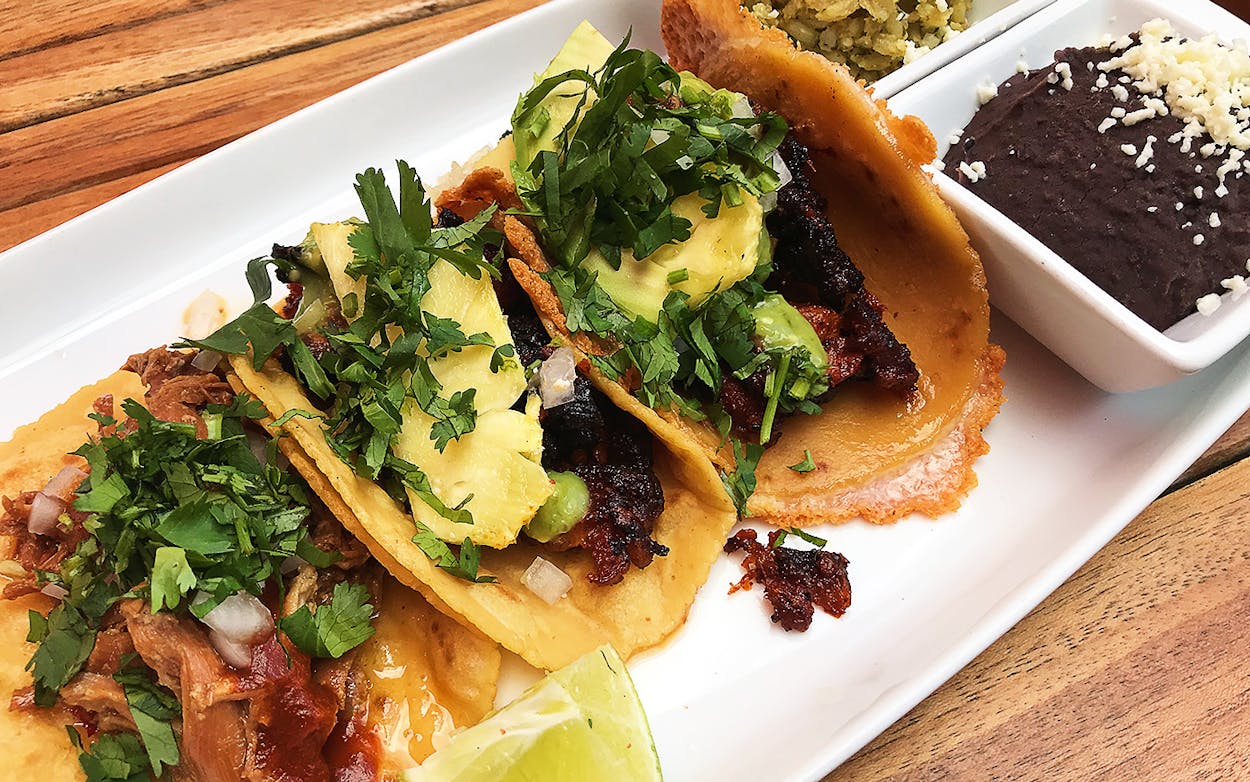For my latest Taco of the Week, I chose the El Corazón from Eddie O’s Texas Barbecue, a pop-up in Houston. What sets this taco apart is the vessel: the brisket taco comes not in a flour tortilla, but in a shell made of griddled cheese. Although pitmaster-owner Eddie Ortiz calls it a tortilla de queso, it is also known widely as a costra taco, and it’s starting to pop up on more menus across the state.
The costra (which can mean “crust”) became popular in Mexico City in the early aughts as a late-night nosh from a taqueria called Las Costras, which was next to the Bandasha nightclub. “When I was still in college in Texas—probably like 2002, 2003, 2004—I went to go see my family, and they took me out to Bandasha,” remembers Markus Pineyro, founder and owner of Urban Taco in Dallas. “Las Costras was right there, outside the nightclub, and it was the perfect food after drinking and dancing. It’s like the best experience in the world.” Las Costras is now a chain, and the taco style is available across Mexico City and the region.
In Texas, the costra’s story goes back about fourteen years along the border. The first mention I could find of a costra taco in the state comes from a 2005 McAllen Monitor article on the now shuttered La Parrilla Grill, in Mission, which served a cheese shell rolled around poblano chiles and a boneless pork chop, and put it on top of a flour tortilla. In 2015, Pineyro’s costra variation, the taco al pastor a la Tuma, made our list of 120 Tacos You Must Eat Before You Die. Since then, I’ve found more costras at taquerias across Texas, including La Vibra Tacos in Houston and Chilangos Tacos in Dallas.
Both serve stellar costras. My favorite at La Vibra is served with rajas tucked into a slick Oaxaca-Gouda roll on a flour tortilla. The tartness of the tamarind salsa adds a beautiful balance to the richness of the cheese and rajas. At Chilangos—where the white tile and red accents give the restaurant an uncanny resemblance to a Mexico City market taqueria—it’s best to opt for the al pastor, prepared on a trompo. It’s an off-menu item but one that is requested often enough to make it a signature item.
“Considering the strategy is to keep it off the menu, we do sell quite a lot,” says owner Jonatan Garay, who opened Chilangos this spring. “If you know, you know. You get one costra and two or three tacos, and that’s a hell of a meal.” Adds Chilangos’ executive taquero, Joel Mendoza: “Even though it’s so simple … the process and the final product change the taco game. That’s how people really know us. The costra was the key to opening the door to this market.”


At the contemporary Mexican restaurant Urban Taco, which Pineyro, a Mexico City native, opened in 2007, the costra didn’t get a permanent menu berth until 2011. The aforementioned taco al pastor a la Tuma was created for the opening of a former location in Dallas’s Uptown neighborhood. “I wanted to do something different, something new that I thought Dallas would embrace, but I didn’t think [costras] were quite ready for prime time,” Pineyro explains. “There was just a little note about it on the menu. That’s it. For us, it was creating a cult around it and an off-menu secret that people kept special by ordering and telling their friends about it.”
In the taco, a thin layer of one-year-aged Spanish Manchego is griddled to a saddle-tan lattice crust and topped with jalapeño slices before a corn tortilla is added to the combination. The cheese sears to the handmade tortilla, concealing the fiery chiles. Next, pork al pastor shaved from the trompo and bathed in habanero salsa, then finished off on the flattop and slid into the cradling taco. There are peeks of the smooth corn disc between the fried cheese. The handheld delight is the first thing every customer should order when seated at Urban Taco. They probably do. “It’s our number one seller,” Pineyro says. He’s leveraging it too. It used to be that customers could only get the pastor in the costra, but now any taco is customizable, even the campechano, a mix of herbaceous chorizo verde and alternately soft and crunchy carnitas, which will be available at least through November if not December.
It’s difficult to peg Urban Taco’s costra style as the one that gave the costra traction in Texas—although as far as I can tell it was the first Dallas taqueria to offer a costra—but it’s no longer alone. Variations, including some using only fried cheese, can be found across the state. El Taco Grill in San Antonio’s Stone Oak area eschews the tortilla completely. Also in San Antonio, Chela’s Tacos offers a classic fried and rolled costra in a tortilla. Not all are successful, though. One example is the costra from a Dallas-based national chain whose version uses Comté cheese, which is too oily and doesn’t melt properly. The result is a gloppy parcel.
“The secret is in the cheese,” Pineyro says. Thankfully, there is more than one option, and taqueros are free to experiment with mixtures. This tinkering will fuel the favor and flavor of costras, whatever taqueros name them.








